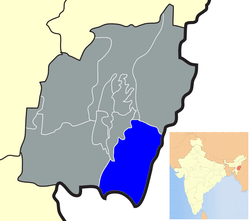Chandel district
| Chandel district Chamdil | |
|---|---|
| District | |
 Location of Chandel district in Manipur | |
| Nickname(s): kankhupam | |
| Coordinates: 24°19′N 93°59′E / 24.317°N 93.983°ECoordinates: 24°19′N 93°59′E / 24.317°N 93.983°E | |
| Country |
|
| State | Manipur |
| Founded by | chamdil |
| Headquarters | Chandel |
| Area | |
| • Total | 521 km2 (201 sq mi) |
| Population (2011) | |
| • Total | 168,217 |
| • Density | 21.83/km2 (56.5/sq mi) |
| Languages | |
| • Official | English,Anal (Naga) and other local languages |
| Time zone | UTC+5:30 (IST) |
| ISO 3166 code | IN-MN-BI |
| Vehicle registration | MN |
| Website |
chandel |
Chandel district (Pron:/ˌtʃænˈdɛl/) is one of the 16 districts of Manipur state in northeastern India. As of 2011 it is the second least populous district in the state, after Tamenglong.[1]
History
This district came into existence on 13 May 1974 as Tengnoupal District. In 1983 the district headquarter was shifted to Chandel, and subsequently it was renamed as Chandel district. Originally the name Chandel was Chamdil, taken from the Anāl (Pakan) language: cham = 'simple', and dil = 'trousers (men's wear)'.
Geography
Chandel town is the administrative headquarters of the district. Moreh town, an important trade centre between Manipur and Myanmar is located at the southernmost part of this district. Chakpikarong town is important where the river Chakpi runs in the middle of the town and a business centre in the district, mainly comprises Anāl KukiTribe. And Tengnoupal town which is also the Sub-Divisional Headquarter is the gate-way to all the roads leading to four corner of the district. Tengnoupal is inhabited by Mate tribe.
Economy
In 2006 the Ministry of Panchayati Raj named Chandel one of the country's 250 most backward districts (out of a total of 640).[2] It is one of the three districts in Manipur currently receiving funds from the Backward Regions Grant Fund Programme (BRGF).[2]
Administrative divisions
The district is divided into 3 sub-divisions:
- Chandel
- Chakpikarong
- Khengjoy
Recently, Tengnoupal District is carved out from Chandel district comprising sub-divisions of Tengnoupal, Moreh, Machi.
Demographics
According to the 2011 census Chandel district has a population of 144,028,[1] roughly equal to the nation of Saint Lucia.[3] This gives it a ranking of 602nd in India (out of a total of 640).[1] The district has a population density of 43 inhabitants per square kilometre (110/sq mi) .[1] Its population growth rate over the decade 2001-2011 was 21.72%.[1] Chandel has a sex ratio of 932 females for every 1000 males,[1] and a literacy rate of 70.85%.[1]
Languages
Languages spoken include Anāl (Pakan), Lamkang and Meitei language in the Headquarter. Anāl, Lamkang, Moyon and Monsang tribe are dominant in the district headquarter and Aimol, a Sino-Tibetan tongue with less than 2500 speakers, written in the Latin script;[4] and Anal, which is also Sino-Tibetan and spoken by approximately 14,000 Indians, and more in Myanmar (and which should not be confused with the Anus language).[5]
Some languages spoken in Chandel district are:
Flora and fauna
In 1989, Chandel [originally Tengnoupal district] became home to the Yangoupokpi-Lokchao Wildlife Sanctuary, which has an area of 185 km2 (71.4 sq mi).[6]
References
- 1 2 3 4 5 6 7 "District Census 2011". Census2011.co.in. 2011. Retrieved 2011-09-30.
- 1 2 Ministry of Panchayati Raj (September 8, 2009). "A Note on the Backward Regions Grant Fund Programme" (PDF). National Institute of Rural Development. Archived from the original (PDF) on April 5, 2012. Retrieved September 27, 2011.
- ↑ US Directorate of Intelligence. "Country Comparison:Population". Retrieved 2011-10-01.
Saint Lucia 161,557 July 2011 est.
- ↑ M. Paul Lewis, ed. (2009). "Aimol: A language of India". Ethnologue: Languages of the World (16th ed.). Dallas, Texas: SIL International. Retrieved 2011-09-28.
- ↑ M. Paul Lewis, ed. (2009). "Anal: A language of India". Ethnologue: Languages of the World (16th ed.). Dallas, Texas: SIL International. Retrieved 2011-09-28.
- ↑ Indian Ministry of Forests and Environment. "Protected areas: Manipur". Archived from the original on October 9, 2011. Retrieved September 25, 2011.